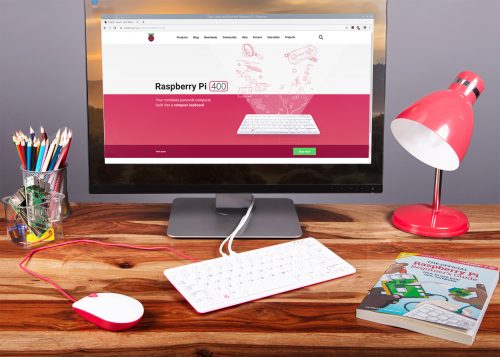
The Raspberry Pi Foundation recently announced the new compact personal computer Raspberry Pi 400, designed as a monoblock with an integrated keyboard.
Also, what is interesting about this new device from the Raspberry foundation is the form factor of the Raspberry Pi 400 immediately reminiscent of the first computers.
About the Raspberry Pi 400
Computer It is based on a modified version of the Raspberry Pi 4 board, equipped with 4 GB of RAM. In addition to the different form factor of the new board, the key difference from the previously released Raspberry Pi 4 boards was the increase in CPU frequency from 1,5Ghz to 1,8Ghz.
The frequency increased due to the implementation of a heat removal system based on a large metal plate to which the keyboard is attached.
On the back of the box, there are connectors: 40-pin GPIO, two micro-HDMI ports, one slotura for MicroSD cards, two USB 3.0 ports and one USB 2.0 port.
To connect to the network, a Gigabit Ethernet port is provided, support for wireless communication (802.11b / g / n / ac 2.4GHz and 5GHz) and Bluetooth 5.0.
Raspberry Pi has always been a PC company. Inspired by home computers from the 1980s, our mission is to put high-performance, affordable, programmable computers in the hands of people around the world. And inspired by these classic PCs, here it is Raspberry Pi 400 - A complete personal computer, built into a compact keyboard.
The operating system comes pre-installed with the Raspberry Pi OS distribution (Raspbian) based on the base of the Debian 10 package "Buster". Optionally, the Ubuntu edition is offered for installation.
On the outward side, the Raspberry Pi 400 is quite different. Raspberry Pi 400 form factor reminiscent of early computers like those of the BBC Micro or ZX Spectrum series.

Depending on the region shopping, the computer is integrated with a 78 or 79 key keyboard Similar in design to most compact laptop keyboards.
At launch, there are six different keyboards: United Kingdom, United States, Germany, France, Italy and Spain. The company reports that other variants will soon be available for the Norwegian, Swedish, Danish, Portuguese and Japanese markets.
In particular, having fewer objects on your desktop makes the setup experience easier. Classic home computers (BBC Micros, ZX Spectrums, Commodore Amigas, and the rest) integrated the motherboard directly into the keyboard. No separate box and system unit; without keyboard cable. Just a computer, a power supply, a monitor cable, and (sometimes) a mouse.
We have never been ashamed to borrow a good idea. Which brings us to the Raspberry Pi 400: it's a 4GB Raspberry Pi 4 traditional speed boat tour y fresh , integrated into a compact keyboard.
Generally speaking, the design would be inspired by how PC manufacturer Acorn Computers used its separate keyboard as the basis for it.
Regarding the specification of the Raspberry Pi 400:
- Broadcom BCM2711 SoC: Quad 8-bit ARMv72 Cortex-A64 cores running at 1.8GHz and a VideoCore VI graphics accelerator that supports OpenGL
- ES 3.0 and is capable of decoding H.265 video in 4Kp60 quality (or 4Kp30 on two monitors).
- 4GB LPDDR4-3200 RAM.
- IEEE 802.11b / g / n / ac wireless LAN, compatible with 2.4GHz and 5GHz.
- Bluetooth 5.0, BLE.
- Gigabit Ethernet
- 2×USB3.0, 1×USB2.0.
- 40-pin GPIO.
- 2 × microHDMI (4Kp60).
- MicroSD.
- 79 button keyboard (layouts available for English, French, Italian, German and Spanish).
- 5V power supply via USB-C.
- Operating temperature range: 0 ° C to + 50 ° C.
- Dimensions 286 × 122 × 23 mm.
Finally, if you want to know more about it about this new device launched by the Raspberry foundation, you can check the details in the original post at the following link, where you can also find information on how to obtain it if you are interested in it.
The machine alone costs $ 70. A package that includes a mouse, power supply, microSD card, HDMI cable, and a beginner's guide is available for $ 100.
Necklaces, euros, pounds, pesos?